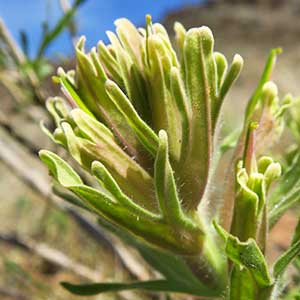Castilleja xanthotricha
Castilleja chambersii
John Day or yellow-hairy paintbrush, John Day paintbrush, yellow hair paintbrush, yellow-hair Indian paintbrush
Chambers' Indian paintbrush, Chambers' paintbrush
few to several, ± decumbent to erect or ascending, unbranched, sometimes with short, leafy axillary shoots, hairs erect to spreading, long, soft, eglandular, mixed with short stipitate-glandular ones.
solitary or few to several, ascending, sometimes short-decumbent and rooting, branched from near base, sometimes distally, glabrous or glabrate with hairs very sparse, ± appressed, very short, soft, eglandular.
green, linear, lanceolate to broadly lanceolate, oblong, or cuneate, 0.8–5 cm, not fleshy, margins plane to wavy, involute, 0–5-lobed, apex acute, sometimes rounded;
lobes spreading, linear, arising below mid length, nearly as broad as center lobe, apex acute.
green, often brown- or purple-tinged, oblong to lanceolate to narrowly ovate or ovate, (1–)2–5.8 cm, not fleshy, margins plane, ± involute, deeply 3–7(–11)-lobed, sometimes with secondary lobes, apex narrowly acute;
lobes erect to ascending, lanceolate to linear-lanceolate to oblanceolate, apex acute.
3–14 × 1.5–4.5 cm;
bracts proximally greenish, rarely dull reddish purple, distally white to cream, rarely pale yellow or dull, pale pink (sharply differentiated from proximal coloration), lanceolate or oblong to narrowly ovate, (3–)5–7-lobed;
lobes ascending, linear to obovate, ± broadened distally, medium, long, proximal lobes arising below mid length, central lobe apex broadly rounded to truncate, others acute to rounded.
3–15 × 2–4.5 cm;
bracts proximally greenish, distally bright red, scarlet, or pale reddish orange, rarely orange-yellow, often fading to pale yellowish orange with age, obovate to orbicular, fan-shaped, (3–)5–9(–13)-lobed, sometimes with secondary lobes;
lobes erect or ascending, lanceolate to triangular, short and medium length, usually arising at or above mid length, rarely below, apex acute.
curved, 17–23 mm;
tube 15–19 mm;
beak exserted, adaxially green, 5–8(–9) mm, puberulent, stipitate-glandular;
abaxial lip deep purple (color sometimes visible through calyx), green, pinkish, or pale yellow, ± prominent, slightly inflated, usually hidden in calyx, sometimes right at top of calyx, 2 mm, ca. 50% as long as beak;
teeth ascending, whitish, yellowish, pink, or green, 1–1.5 mm.
straight, 30–45 mm;
tube 14–19 mm;
beak long-exserted, adaxially green or yellow-green to brownish, 18–24 mm;
abaxial lip deep green, reduced, 1–3 mm, 10% as long as beak;
teeth incurved, greenish to dull purplish, 0.5–1.5 mm.
colored as bracts, 15–26 mm;
abaxial and adaxial clefts 3.5–7 mm, 25–50% of calyx length, deeper than laterals, lateral 2–5 mm, 12–25% of calyx length;
lobes linear, oblong, or narrowly triangular, center lobe apex usually rounded, lobes acute to rounded.
proximally green, sometimes purple to brown, distally colored as bracts, 20–30 mm;
abaxial and adaxial clefts 7–14 mm, ca. 33% of calyx length, deeper than laterals, lateral 2–4 mm, 10–15% of calyx length;
lobes triangular, barely longer than wide, apex acute or acuminate to obtuse.
= 48.
= 24.
Castilleja xanthotricha
Castilleja chambersii
Castilleja xanthotricha is endemic to moderate elevations in the sagebrush hills of the John Day River drainage in north-central Oregon. N. H. Holmgren (1971) hypothesized that this tetraploid species is of allopolyploid hybrid origin between C. glandulifera and C. oresbia.
(Discussion copyrighted by Flora of North America; reprinted with permission.)
Castilleja chambersii is limited to the summits of three volcanic peaks in the northern Coast Range of Clatsop County, Oregon, and at one similar area in nearby Pacific County, Washington. It is similar to C. rupicola, and the two likely share a common ancestor. Disturbance and erosion from logging and road construction represent significant threats to C. chambersii. Populations of C. chambersii often grow near and even alongside C. hispida, but hybrids are rare.
(Discussion copyrighted by Flora of North America; reprinted with permission.)



